Hi Direktore and welcome! You are here because you love Serbian food. And the way you feel about Serbian cooking will never be the same after munching on the intense and rich flavors of Serbian Cuisine.
We will be cutting through 40+ best Serbian food recipes that you can absolutely prepare in the comfort of your home and they will still taste insane.
Do not be confused if you read “The best Serbian food” way too many times. They all are, leaving little to no space for only one at the throne.
Which one? We will leave it to you direktors, to decide.
We know how important soul food is to you, and each and every dish here fills it up to the max.
Let’s dive in.
Appetizers
Uštipci
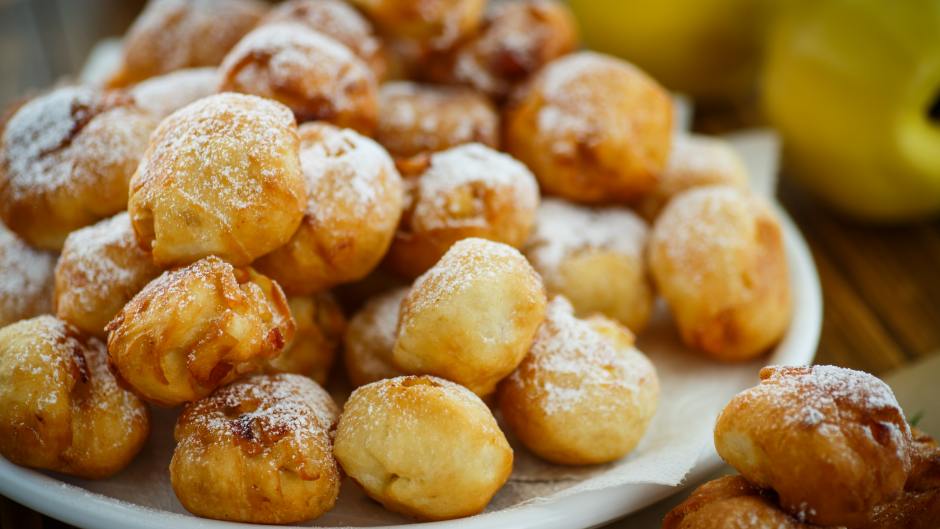 Uštipci are little chunks of meat mixture, molded like a donut and seared in oil.
Uštipci are little chunks of meat mixture, molded like a donut and seared in oil.
Uštipci is adored to the point that it tends to be served sweet or savory, with or without sides, as an appetizer or a treat.
Don’t be afraid to make it your primary course.
Uštipci is a famous dish in Serbian cuisine, particularly in Vojvodina, in the northern side of Serbia.
Uštipci is likewise served as a treat, presented with sugar sprinkled on top or with jam. They are similar to fritule, and also to krofne but with more of a soft, bread-like feel to them. One of the best serbian food to try!
Šopska/Srpska salad
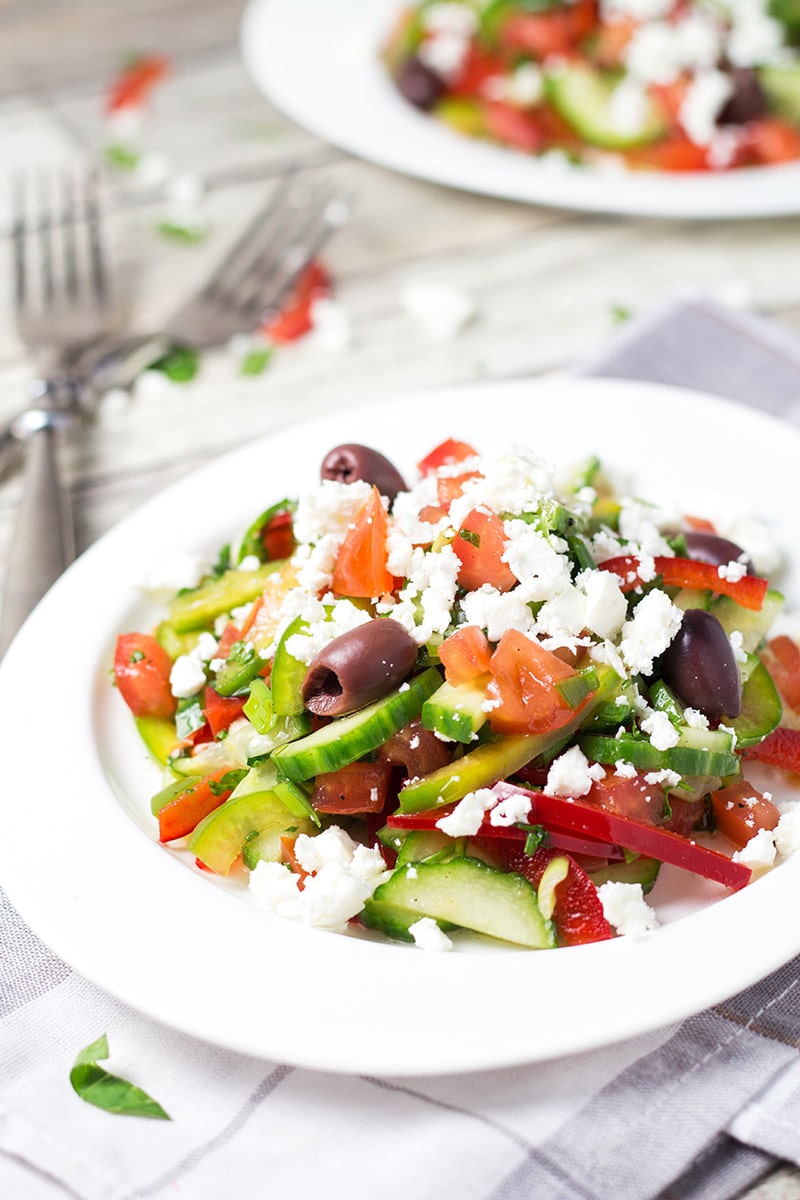 Serbian salad is a summer vegetable salad that is commonly eaten with roast meat and other main meals across the country. Is it the best Serbian food? Let’s find out.
Serbian salad is a summer vegetable salad that is commonly eaten with roast meat and other main meals across the country. Is it the best Serbian food? Let’s find out.
It’s made with diced fresh tomatoes, cucumbers, and white onions, typically seasoned with sunflower or olive oil, salt, and feferon, a spicy pepper that’s close to cayenne pepper.
On top goes sprinkled white hard cheese, and the mouthful taste is out of this world!
The salad appeared at the Black Sea coast, in a resort near Varna, called Druzhba.
World-class appetizer when served with rakija!
Served with: Rakija
Want to make it at home? Click here!
Serbian salad is similar to Israeli Salad, Çoban salatası, Moravska salata.
Where To Eat Srpska salad: This Serbian Restaurant
Gibanica
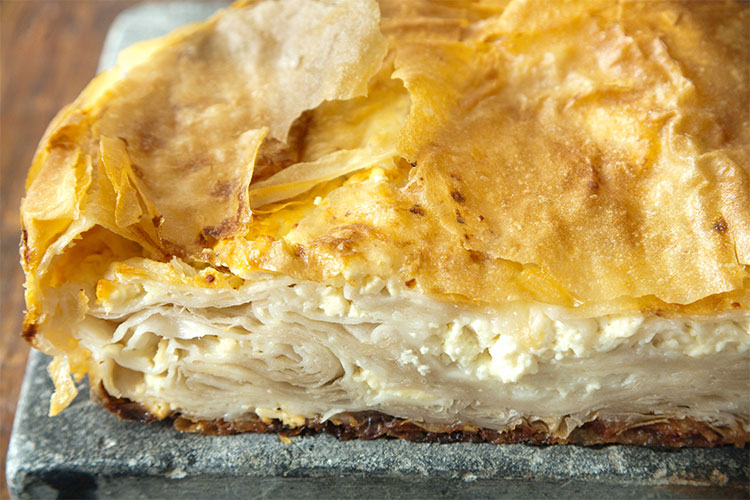 Gibanica is a baked pastry produced using a filo mixture, hard white cheese, and eggs. Now and again alluded to as a guzvara, as a result of how it is prepared.
Gibanica is a baked pastry produced using a filo mixture, hard white cheese, and eggs. Now and again alluded to as a guzvara, as a result of how it is prepared.
Gibanica is mostly associated with Serbian cuisine, but it can also be found within Croatian, Slovenian, and Macedonian cuisine too.
Gibanica is a dish served at various events. Accompanied with yogurt or milk, it is served as breakfast or dinner. Often consumed as a starter or snack, also. It is a vital piece of the feasting table for occasions like Christmas or Easter.
Want to make it at home? Click here!
Similar dishes to Gibanica are Achma, Tsouknidopita, and Tiropita
Where To Eat Gibanica: This Serbian Restaurant
Ajvar (Ayvar)
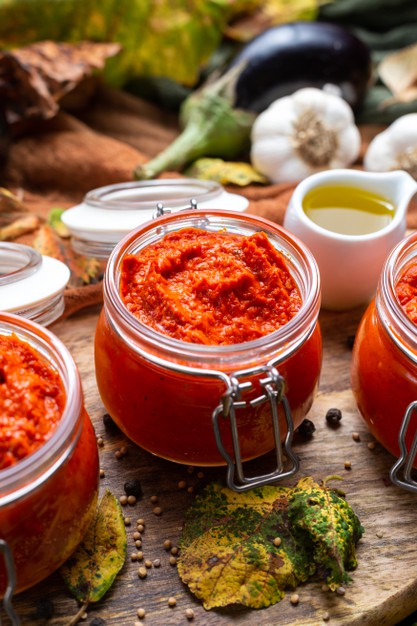
Ajvar is a dip made of broiled sweet peppers and eggplants.
Often garlic and tomatoes are added for a more complex flavor. Some of the time alluded to as veggie lover caviar.
Domestic ajvar, or “caviar,” used to be a common Belgrade traditional food in homes and restaurants, but labor disputes caused domestic caviar production to falter beginning of the 1890s.
In Belgrade restaurants, a special pepper salad known as “red ajvar” (crveni ajvar) or “Serbian ajvar” was eventually introduced as a replacement (srpski ajvar).
It tends to be pounded or left stout, contingent upon individual taste, and filled in as a relish, vegetable, or spread on country-style white bread like pogacha as a canapé.
Its smoky flavor is an incredible addition to flame-broiled or cooked meats, particularly lamb. Ajvar is likewise commonly presented with cevapi and bread known as lepinje.
Want to make it at home? Click here!
Similar dishes: Toad in the Hole, Katsu karē, Shashlik, Carne fiesta
Where To Eat Ajvar: This Serbian Restaurant
Urnebes
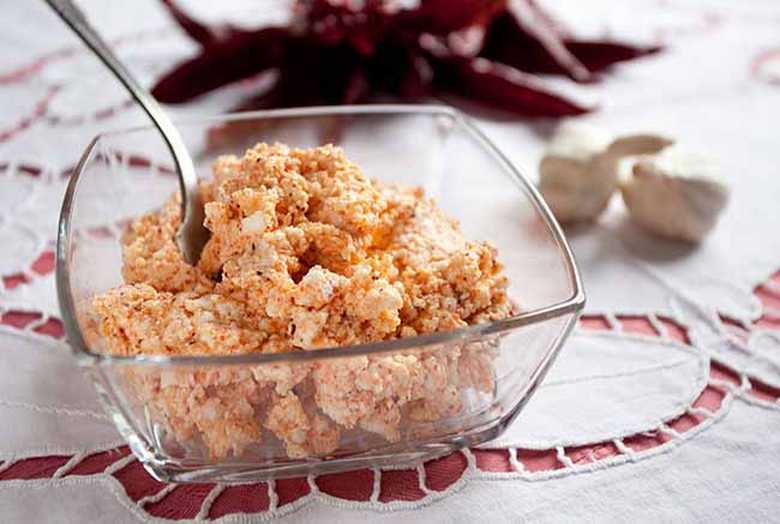 Perhaps the most mainstream of Serbian plunges is the Urnebes Salad. Urnebes Salad is a type of salad characteristic of Serbian cuisine prominent in the city of Niš.
Perhaps the most mainstream of Serbian plunges is the Urnebes Salad. Urnebes Salad is a type of salad characteristic of Serbian cuisine prominent in the city of Niš.
The most popular South Serbian urnebes versions are PAPRIKA or RED PEPPER, both mild and chilly – and this is what gives the salad its kick and special touch.
Most of the time is a starter or palate teaser for what follows next.
Indeed, even its name „URNEBES” means CHAOS.
Served with: Rakija
Want to make it at home? Click here!
Similar dishes: Chipa guasu, Blitva na lešo, Arroz rojo, Plátano frito
Where To Eat Urnebes: This Serbian Restaurant
Kajmak
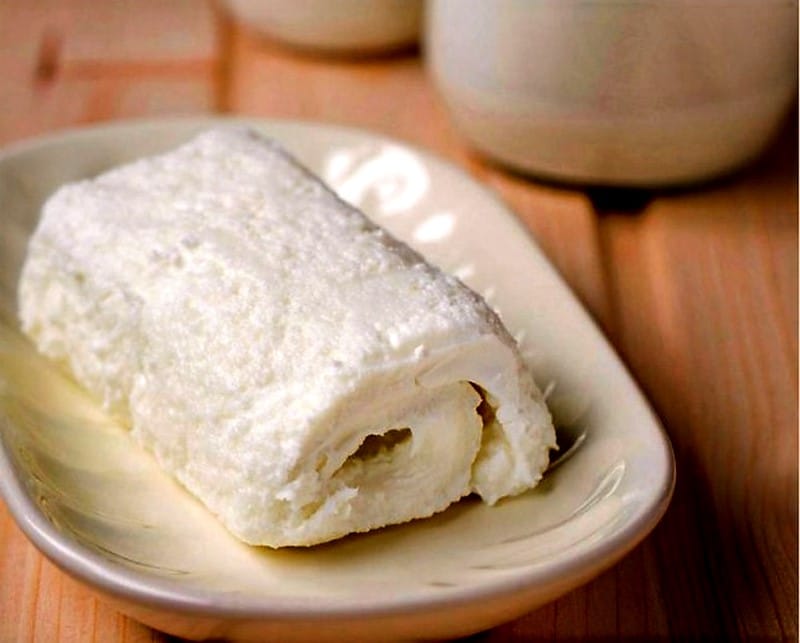 Kajmak is a fresh dairy cream, wealthy in milk fat, with a particular flavor and thick, creamy consistency. Rich in milk fat, it will blow your senses away if you spread it over lepinje as an appetizer.
Kajmak is a fresh dairy cream, wealthy in milk fat, with a particular flavor and thick, creamy consistency. Rich in milk fat, it will blow your senses away if you spread it over lepinje as an appetizer.
Even though kajmak is utilized in numerous global foods all through the Center East and South-East Europe, it’s perceived as a unique national meal in Serbian cuisine.
Served with: Pljeskavica
Want to make it at home? Click here!
The English equivalent, at least for the main aroma, is skim milk.
Where To Eat Kajmak: This Serbian Restaurant
Prebranac
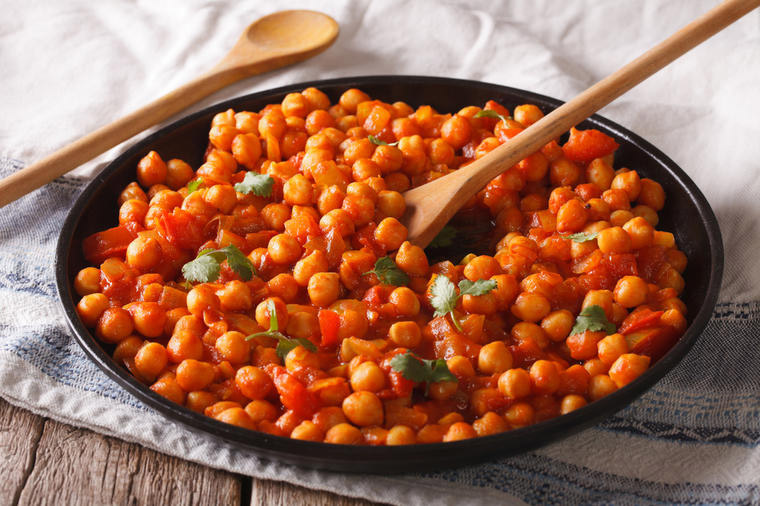 Prebranac is a traditional dish from Serbia, Bosnia and Herzegovina, and Macedonia and is typically served at room temperature with warm crusty bread.
Prebranac is a traditional dish from Serbia, Bosnia and Herzegovina, and Macedonia and is typically served at room temperature with warm crusty bread.
It’s a casserole of caramelized onions and white beans in a sauce with bay leaves and sweet Hungarian paprika, and it’s one of the classic foods in Serbia.
It’s a nutritious, wholesome dish that was originally made by farmers during long winters. It’s also one of the cheapest dishes ever made.
Want to make it at home? Click here!
Similar dishes to Prebranac are Houbový kuba, Arroz imperial and Porkkanalaatikko.
Where To Eat Prebranac: This Serbian Restaurant
Burek
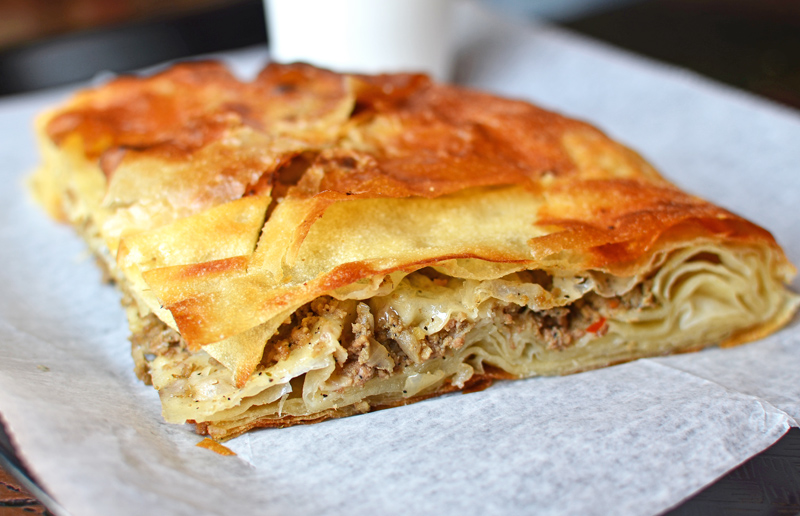 Burek wears the crown of being one of the best Serbian foods.
Burek wears the crown of being one of the best Serbian foods.
This is a pastry with flaky dough filled with meat, cheese, or spinach.
It is baked in many different ways, depending on the region of Serbia. In the traditional homemade style, Burek was and still is finger food eaten in homes for breakfast or dinner.
You can find it on almost every corner of the streets throughout Serbia. And each will taste differently, yet insanely tasty.
Börek was a popular element of Ottoman cuisine and may have been invented at the Ottoman court, though there are also indications it was made among Central Asian Turks.
Served with: Yogurt
Similar foods to Burek are Zelnik, Kol böreği, Sirnica, Su böreği.
Where To Eat Burek: This Serbian Restaurant
Bela Čorba (White Stew)
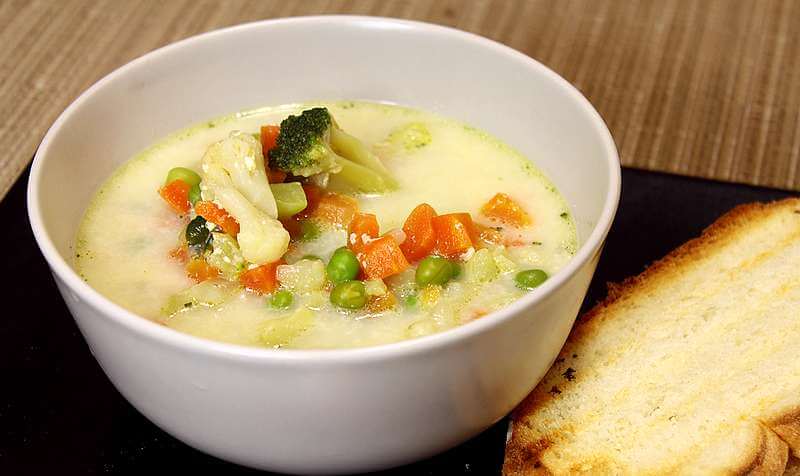 Bela Čorba, one of Serbian cuisine’s fancier stews, is served on holidays and special occasions, though not exclusively.
Bela Čorba, one of Serbian cuisine’s fancier stews, is served on holidays and special occasions, though not exclusively.
The stew’s foundation is essentially a chicken soup that has been finished off uniquely.
A mixture of egg yolk and sour cream is added near the end of the cooking process to both make the stew appear white, hence the name, and to give it a creamy and tangy flavor.
Want to make it at home? Click here!
Similar to Bela Corba are Chicken and Corn Soup, Chikhirtma, Ciorbă de pui.
Where To Eat Bela Corba: This Serbian Restaurant
Proja
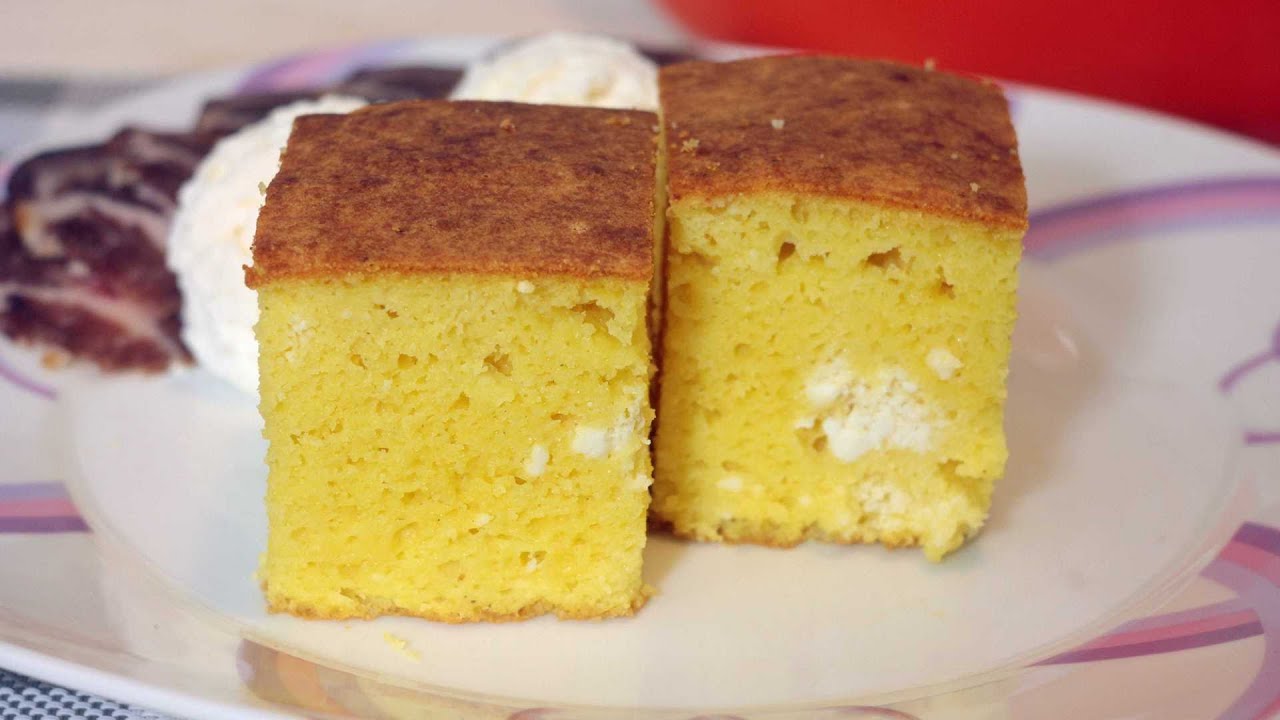 Cornmeal, wheat flour, eggs, and sparkling water are used to aerate the filling in proja, a typical Serbian traditional food.
Cornmeal, wheat flour, eggs, and sparkling water are used to aerate the filling in proja, a typical Serbian traditional food.
It’s normally packed with cheese, but it’s not uncommon to see experimental versions with vegetables (most often spinach) or even ham.
Proja can be eaten as a snack or as a more flavorful alternative to bread, and it goes well with almost every meal as a side dish.
Served with: Kiselo mleko (Sour cream)
Want to make it at home? Click here!
Similar dishes to Proja are Salt-Rising Bread, Cornbread, Baursak, Mchadi.
Where To Eat Proja: This Serbian Restaurant
Lepinja
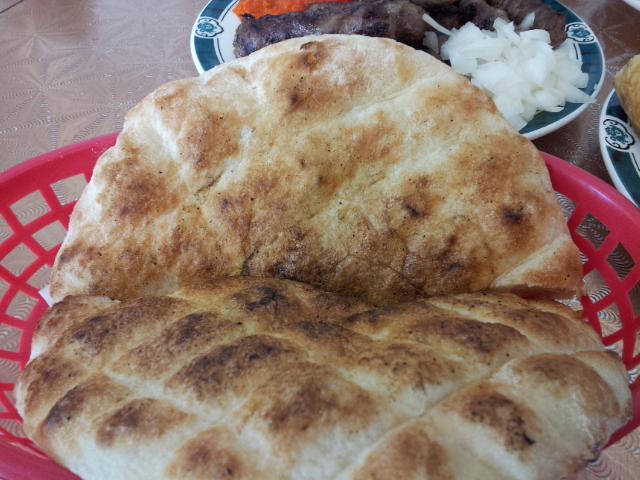
A light, easily digestible bread with a crusty, browned exterior made out of only a few ingredients: flour, salt, water, and oil.
Lepinja is one of the best Serbian foods and remains on many family tables in its original form – baked over an open flame or a coal fire as it was when first introduced.
In the Serbian region of Rodopa on the banks of the Danube, it has been baked for centuries.
Want to make it at home? Click here!
Lepinja is similar to Somun, Mjukkaka, Roti canai.
Where To Eat Lepinja: This Serbian Restaurant
Česnica
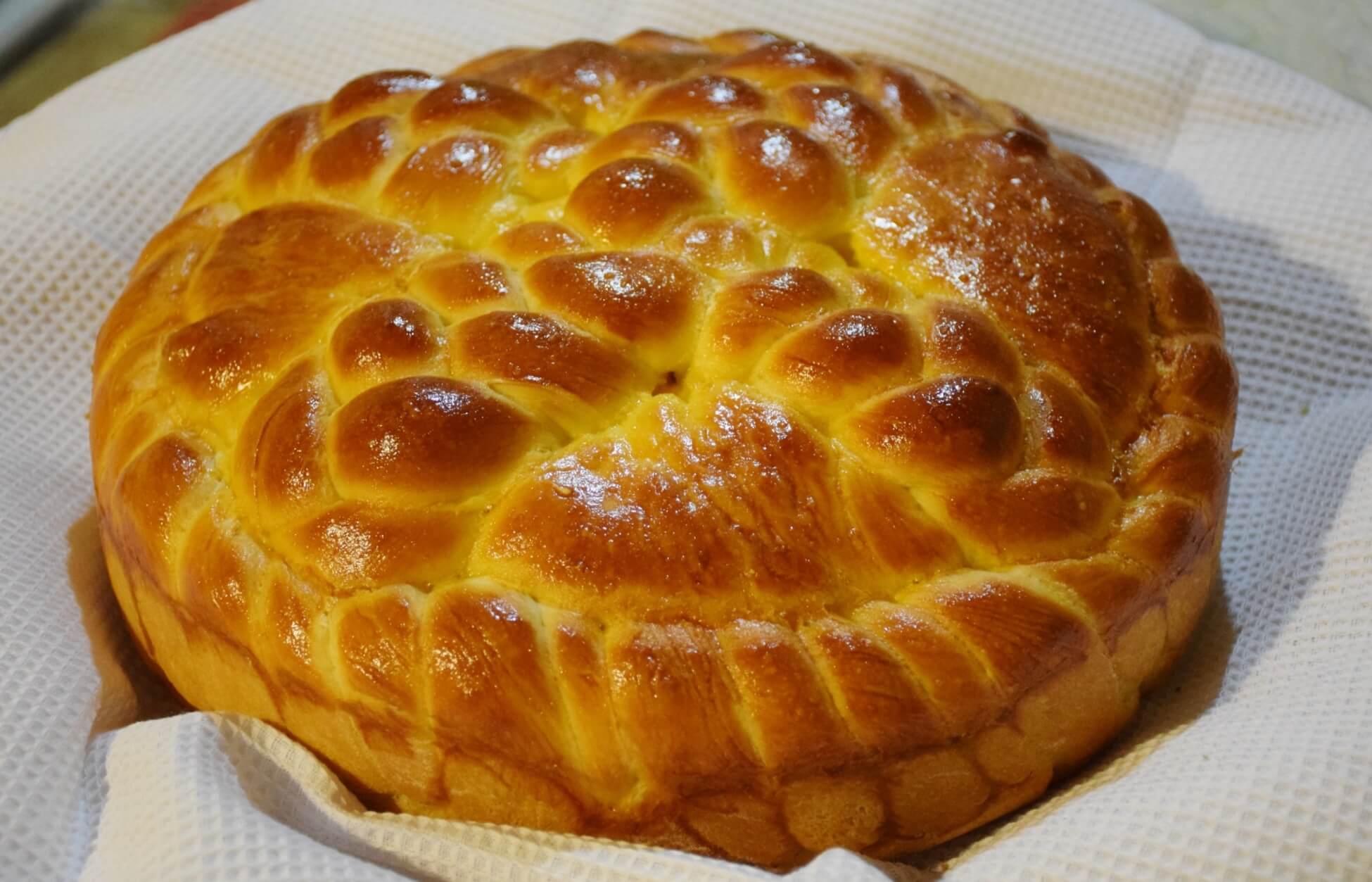 A česnica, also known as Božićna pogača, is food in Serbia, which is a ceremonial, round loaf of bread that is an essential part of Serbian Christmas dinner.
A česnica, also known as Božićna pogača, is food in Serbia, which is a ceremonial, round loaf of bread that is an essential part of Serbian Christmas dinner.
Flour, salt, water, and yeast are used to create Cesnica.
During the kneading process, a coin or other small object is often inserted into the dough. The česnica is rotated three times counterclockwise at the start of Christmas dinner before being split among the family members.
The one who gets the part with the coin inside is believed to be the lucky one for the year, and very blessed.
Want to make it at home? Click here!
Similar dishes to Cesnica are Mjukkaka, Roti canai.
Where To Eat Cesnica: This Serbian Restaurant
Pinđur
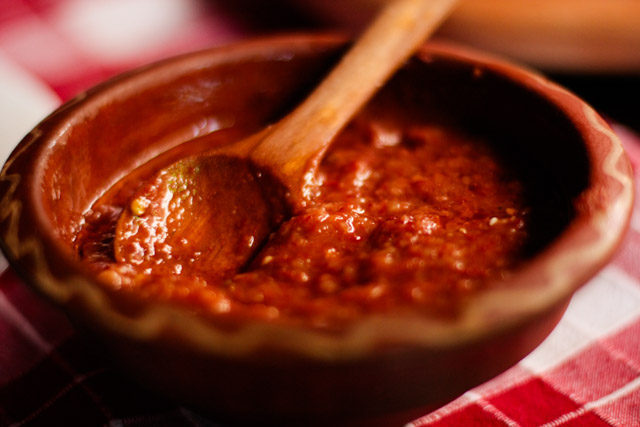 Pindjur is a form of relish that is commonly served as a summertime spread.
Pindjur is a form of relish that is commonly served as a summertime spread.
Red bell peppers, onions, garlic, vegetable oil, and salt are among the basic ingredients. Ajvar is similar to pindjur, but pindjur is made with eggplants.
In some places, the terms are interchangeable.
Pindjur is a Bosnian and Herzegovina, Bulgarian, Serbian, and North Macedonian dish. Or simply labeled, a Balkan dish that every household has during the whole year.
Want to make it at home? Click here!
Similar dishes to Pindjur are Pikliz, Chakalaka, Curtido
Where To Eat Pindjur: This Serbian Restaurant
Pihtije
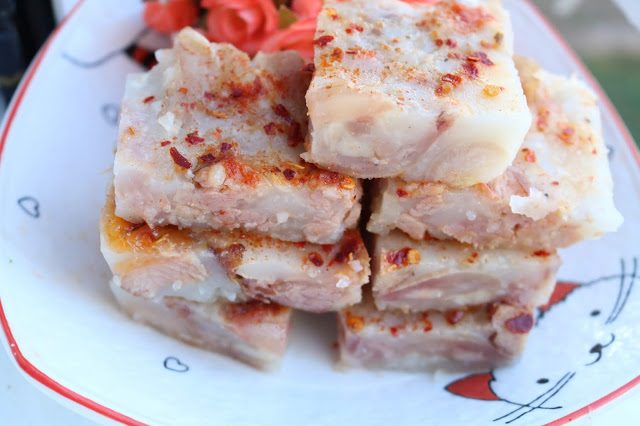
During the Serbian winters, frugal families made pihtije to make the most of limited resources and freezing temperatures.
Out of desperation and spare pig parts came the jellied pork starter, which is still eaten around the country today.
This cold appetizer is the best Serbian food, which is traditionally served with pickled vegetables such as sauerkraut, pickles, bell and hot peppers, and green tomatoes.
Want to make it at home? Click here!
Similar dishes to Pihtije are Uzené, Golonka, Pulled Pork.
Where To Eat Pihtije: This Serbian Restaurant
Kiflice
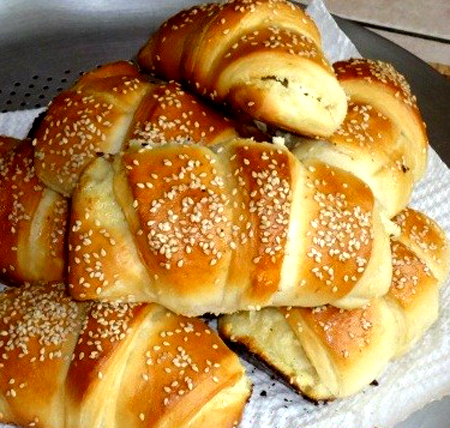
It’s a popular food in Serbia, Central Europe, and neighboring countries, and it goes by a variety of names. It’s thought to be the inspiration for the French croissant, which is similar in form but made with a different dough.
Most commonly served for celebratory occasions or any day when the whole household craves something soft and delicious.
These are croissant-shaped bread formings, that can be filled with savory or sweet fillings, or eaten plain. Hard white cheese, ham, and cheese, jam, or hazelnut spread are the most common fillings (Nutella or Eurocrem).
While kiflice are typically soft and tender, they can also have a crumbly texture, which is more commonly filled with fruit jam.
Want to make it at home? Follow this Kifle recipe!
Where To Eat Kiflice: This Serbian Restaurant
Ljutenica
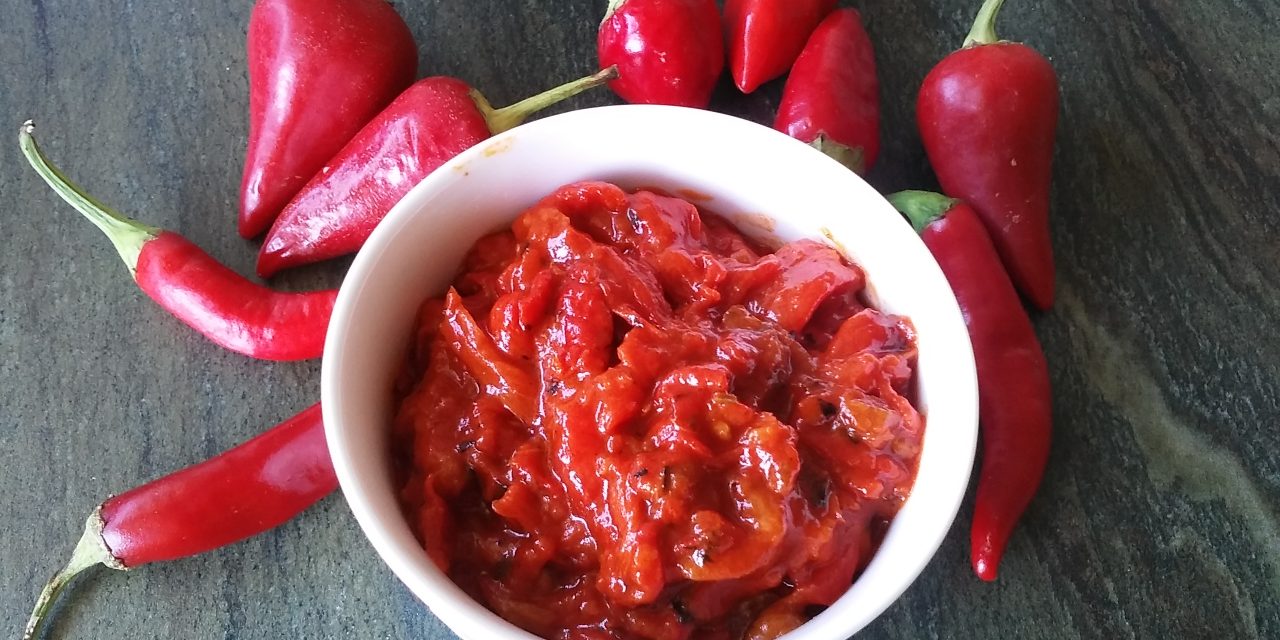 Ljutenica is a simple Serbian dish with origins in the northern parts of the country. It is widely consumed in Serbia, Bosnia, Macedonia, and Montenegro and you can find lots of different versions of the dish.
Ljutenica is a simple Serbian dish with origins in the northern parts of the country. It is widely consumed in Serbia, Bosnia, Macedonia, and Montenegro and you can find lots of different versions of the dish.
This dip is composed of broiled and peeled bell peppers, aubergines, onions, garlic, vegetable oil, sugar, salt, and tomatoes.
Want to make it at home? Click here!
Where To Eat Lutenica: This Serbian Restaurant
Main courses
Sarma
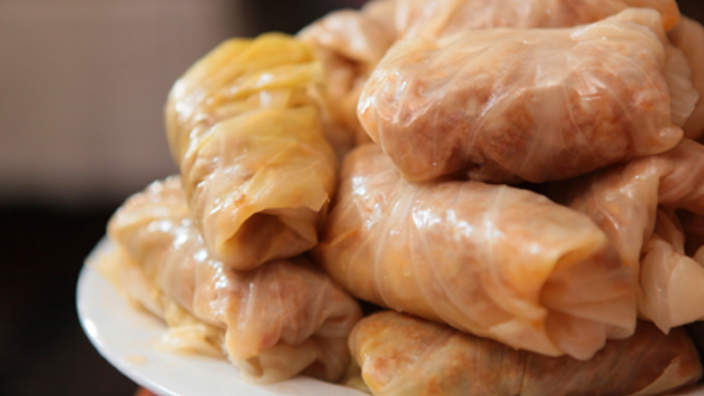 Serbian stuffed cabbage, or sarma, is one of the best Serbian food. It’s a generous dish that numerous Serbs traditionally serve during special events like slavas, Serbian dinner, and different occasions.
Serbian stuffed cabbage, or sarma, is one of the best Serbian food. It’s a generous dish that numerous Serbs traditionally serve during special events like slavas, Serbian dinner, and different occasions.
Recipes may vary from one cook to another, yet they all comprise a meat and rice filling enclosed by cabbage.
The real, authentic Sarma is rolled with entire heads of tenderized cabbage (Sauerkraut), where each leaf is filled and rolled out into a round, circular shape then placed in a pot for slow cooking.
Having its origins in the Ottoman Empire, sarma is generally devoured in the Balkans, the nations of Central Europe, the South Caucasus, and the Middle East.
Served with: Proja
Want to make it at home? Click here!
Similar dishes to sarma are Fylla, Gołąbki, Tolma
Where To Eat Sarma: This Serbian Restaurant
Ćevapi (Chevapi)
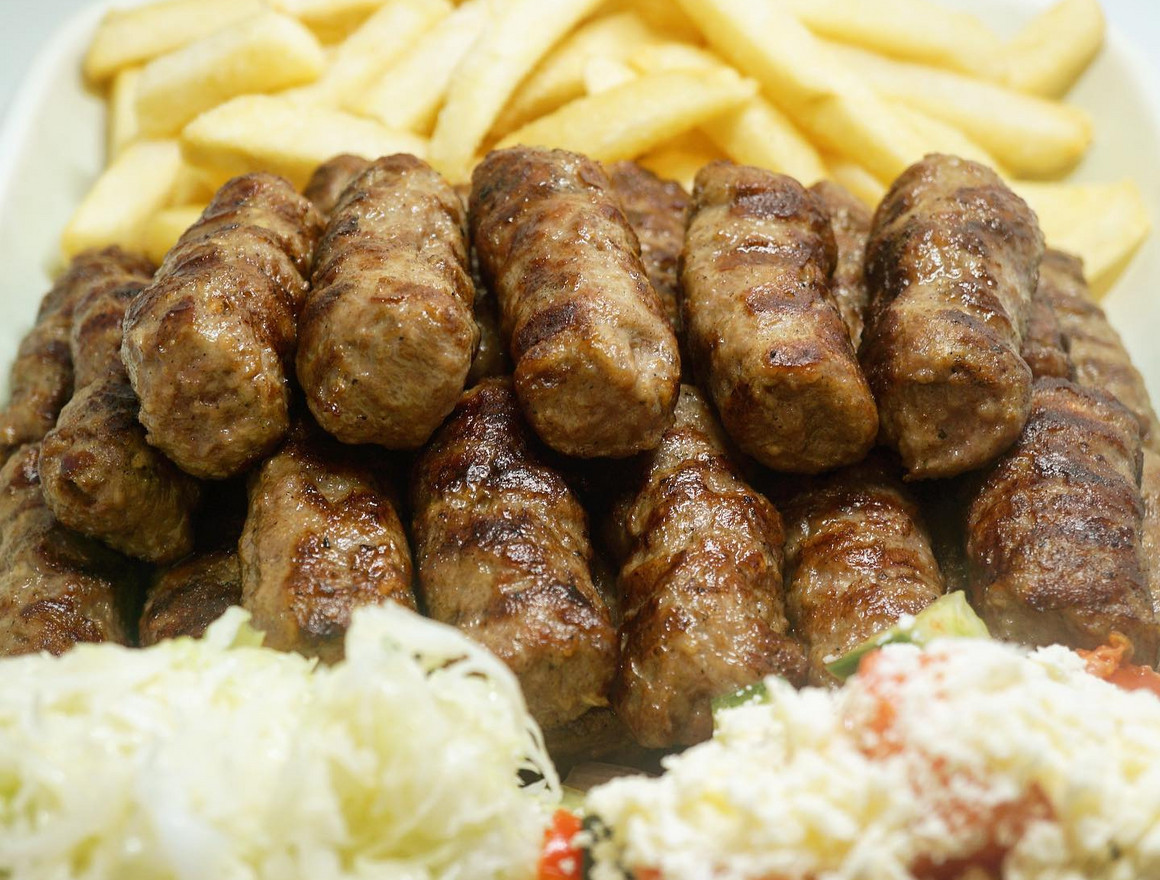 Ćevapi are delightful, expertly barbecued sausages pervaded with an interesting smoky flavor and one of the best Serbian food that truly represent Serbian cuisine.
Ćevapi are delightful, expertly barbecued sausages pervaded with an interesting smoky flavor and one of the best Serbian food that truly represent Serbian cuisine.
Today, these humble flavorsome skinless sausages made with finely ground meat (pork or beef), always married with slashed onions, garlic, and paprika are praised as the quintessential Balkan fast food.
One nibble and you taste the historical backdrop of the Balkans (or the back of the pig).
Traditionally prepared on Labour day or any given day in nature for a barbeque or picnic.
But please, don’t wait for Labour day to try them 🙂
Served with: Lepinja (Circular homemade flat buns), Ajvar, Fries
Want to make it at home? Click here!
Similar dish to ćevapi is köfte kebab.
Where To Eat Chevapi: This Serbian Restaurant
Pljeskavica
 Pljeskavica is a mainstream patty dish, second just to ćevapćići.
Pljeskavica is a mainstream patty dish, second just to ćevapćići.
Leskovačka (pljeskavica from Leskovac) is quite possibly the most well-known pljeskavica in Serbia and is generally made of beef or pork minced mead, grilled and presented with onions.
There are, however, numerous alternate methods of serving it like Šarska and Hajdučka.
Šarska pleskavica is made of meat and on the inside with kashkaval cheese.
Once you cut through, all the melted cheese runs down your plate. Hajdučka pljeskavica is made of beef blended in with smoked pork meat.
It is frequently presented with kajmak, ajvar, and urnebes.
Want to make it at home? Click here!
Similar dishes to Pljeskavica are Antikristo, Asado, Khorkhog.
Where To Eat Pljeskavica: This Serbian Restaurant
Karađorđeva šnicla
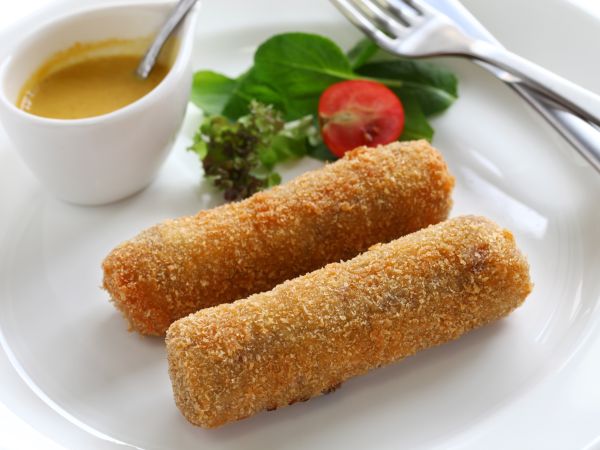
Karađorđeva šnicla is a traditional Serbian dish made of veal or pork cutlet filled with kajmak, breaded, and fried in hot oil. It holds a very special place in Serbian cuisine, and it is said to be one of the best Serbian food.
Popular Serbian chef Milovan Stojanovic created this dish in 1956, and it was named after Serbian prince Karadjorjde Petrovic, the leader of the first Serbian rebellion against the Ottomans.
Served with roasted potatoes, a lemon slice, and tartar sauce on the side, the dish is now a highlight at many traditional restaurants.
Want to make it at home? Click here!
Similar dishes to Karađorđeva šnicla are Cotoletta alla Milanese, Kotlet schabowy, Řízek, Zagrebački odrezak, Cordon Bleu.
Where To Eat Karađorđeva šnicla: This Serbian Restaurant
Fish paprikash
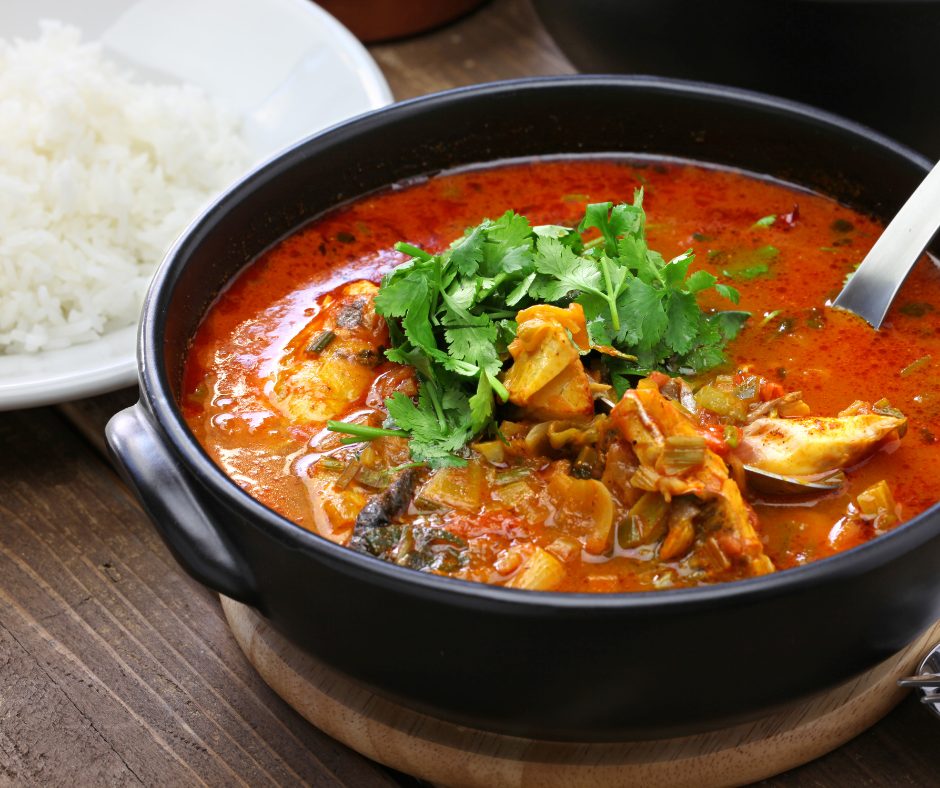
Authentic riblji paprikaš (fish stew) is an awesome choice for pescetarians looking for the best Serbian food.
There are many variations on how to make this traditional Serbian food, but unlike most soups, it contains no potatoes and uses mostly fish. Traditionally prepared, it is served over hard crusty bread or ‘funge’ which in Serbian is known as ‘funka.’
The recipe comes from the city of Niš, Serbia on the banks of the river Nišava.
Served with: Tagliatelle
Want to make it at home? Click here!
Similar dishes to fish paprikas are Fish lolo, Matelote, Bouillabaisse, Pôchouse
Where To Eat Fish paprikas: This Serbian Restaurant
Punjene paprike
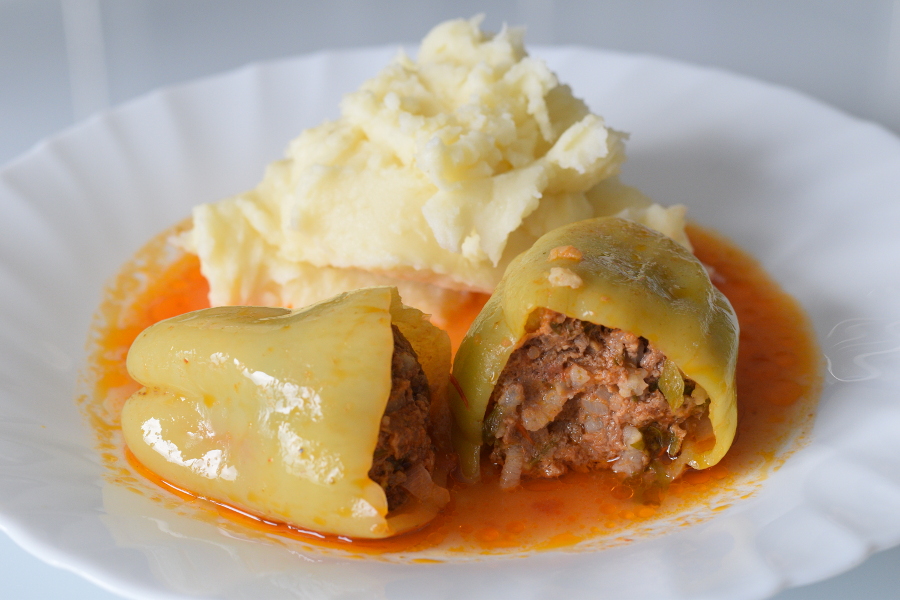 Punjene paprike or stuffed bell peppers is nationally recognized as one of the traditional best Serbian food recipes that are known all across the world.
Punjene paprike or stuffed bell peppers is nationally recognized as one of the traditional best Serbian food recipes that are known all across the world.
The term “punjene” means filled – so punjene paprike are peppers or bell peppers that are filled with a variety of ingredients, most commonly meat and rice.
It originated in the region of Vojvodina, which is where the city of Novi sad is located.
Served with: Mashed potatoes
Want to make it at home? Check this Punjene Paprike recipe!
Similar dishes to Punjene paprike: The Japanese version – sushi (not even close!).
Where To Eat Punjene paprike: This Serbian Restaurant
Svadbarski kupus
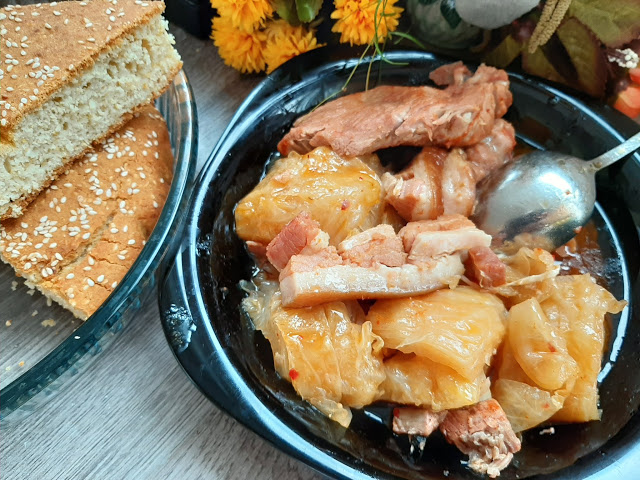
It’s a food in Serbia that is usually served at weddings and other big occasions.
Cabbage and meat, such as pork, bacon, lamb, or mutton, are the main ingredients for this so-called “Wedding cabbage”.
Small cubes of cabbage are sliced, after bacon, cabbage, and meat are layered in the crock.
Lastly, water is added until it’s fully covered, and the pot is brought to a boil and left to simmer for a few hours.
Want to make it at home? Click here!
Svadbarski kupus is a dish similar to Stinco con verdure, Gulasz, Guláš.
Where To Eat Svadbarski kupus: This Serbian Restaurant
Podvarak
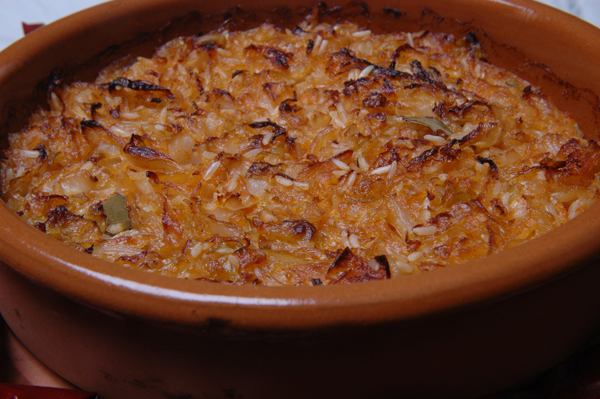
This nourishing and delectable specialty is made with fermented cabbage and some kind of juicy meat.
From what you’ve read, you can safely assume that Serbs simply love the combo of cabbage and meat. Roasted pork or smoked turkey work well, but chicken can also be used.
After that, the fermented cabbage and meat are baked in a preheated oven until golden brown and caramelized.
The great thing about podvarak is that it tastes much better the next day. Cook plenty for a two-day feast!
Want to make it at home? Click here!
Where To Eat Podvarak: This Serbian Restaurant
Škembići
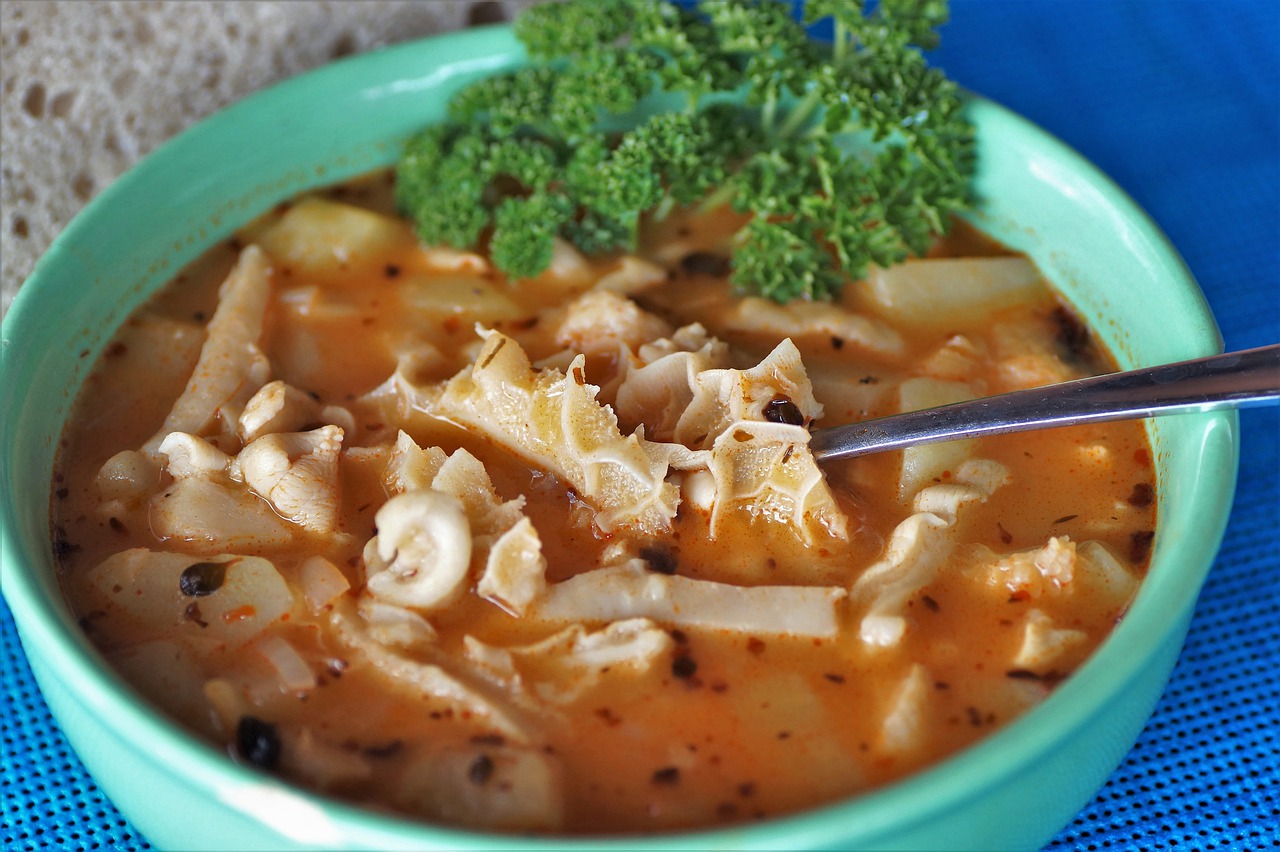
This dish is served in a stew made of different vegetables and spices and is typically served accompanied by boiled potatoes for a truly filling and excellent meal.
You’ll discover tripe soup in many adjoining nations, and on the off chance that you truly need to have a go at something new and conventional, this is the dish to have.
Skembici is an old Serbian national dish, considered one of the genuine Serbian delights by local people. This is a tripe soup that must be tried and definitely holds the top of the best Serbian food list.
Where To Eat Škembići: This Serbian Restaurant
Similar dishes to Škembići: None.
Đuveč

Djuvec is a hearty food in Serbia, a casserole of vegetables, meat, and rice that needs only a few basic ingredients and it will impress and nourish your guests.
Serve it to guests who are coming over, or bring it to a potluck and expect to be showered with compliments.
When they bake and caramelize, they release a beautiful sweetness that drips down and infuses the entire dish.
Djuvec is layered pork, vegetable, and rice casserole topped with a layer of tomato slices in Serbia and other former Yugoslavia countries.
Want to make it at home? Click here!
Similar dish to Djuvec is Ratatouille.
Where To Eat Djuvec: This Serbian Restaurant
Mućkalica
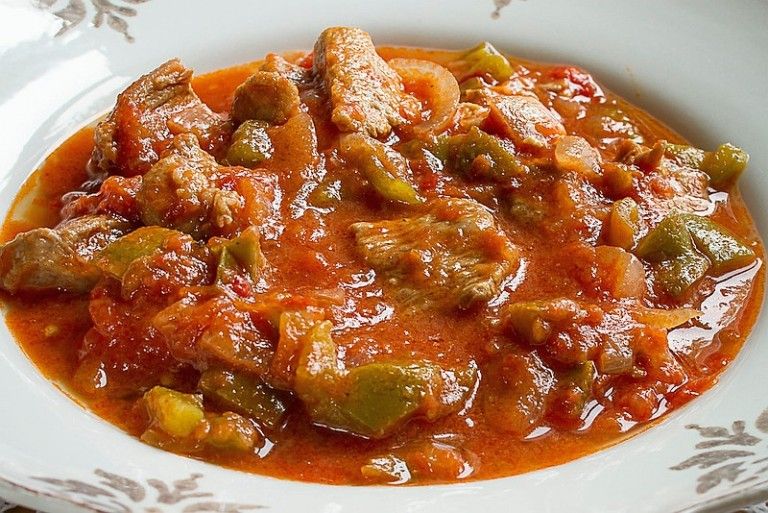 Muckalica, also known as Leskovac muckalica, is one of the best Serbian food for direktors.
Muckalica, also known as Leskovac muckalica, is one of the best Serbian food for direktors.
It’s a kind of stew made with leftover barbecued meat baked in a vegetable sauce. The meal includes leftovers from the previous day’s barbecue as well as vegetables such as peppers, onion, garlic, and tomatoes.
It’s a food in Serbia that originates in the town of Leskovac in southern Serbia.
Leskovac is known for its barbecue, ajvar, and the Leskovac grill, in addition to muckalica. So no wonder they invented this dish, after all, no barbeque should ever be wasted.
Want to make it at home? Click here!
Similar dishes to Muckalica are Katsu karē, Toad in the Hole, Carne fiesta.
Where To Eat Muckalica: This Serbian Restaurant
Popara
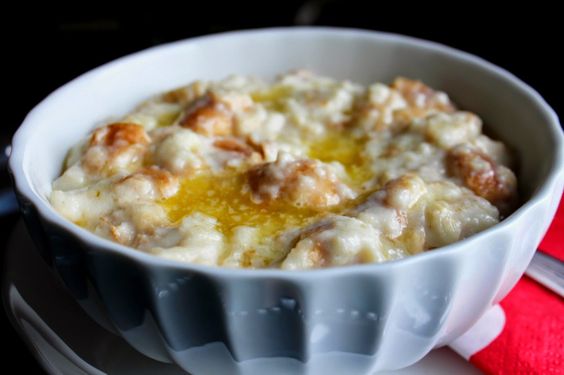
Popara, the Balkan version of bread mash, is an ancient dish that has long been valued as a fast and easy way to use up leftover bread while also feeding the entire family.
Bread, diced or broken into smaller parts, and a liquid, typically milk, water, or tea, that is used to mix the bread into a soft mass are the two essential ingredients.
Want to make it at home? Click here!
Popara is similar to Crumpet, Milk Toast, Fetoydia.
Where To Eat Popara: This Serbian Restaurant
Img src: https://i.pinimg.com/564x/1c/4f/f2/1c4ff2e9f9cff902ed3346b443708bca.jpg
Kačamak
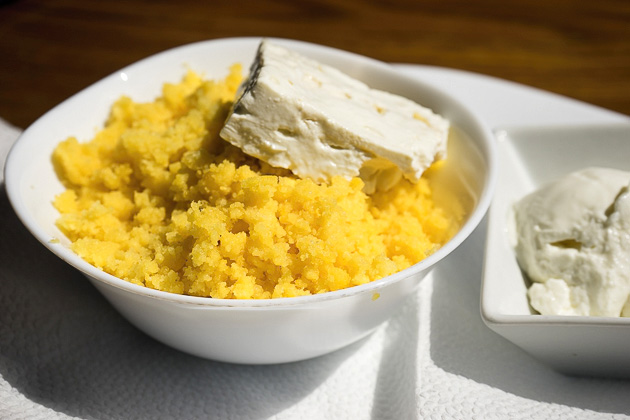 Cornmeal is used to make the dish. Often potatoes, milk, white cheese, or kaymak are added. It’s made by boiling cornmeal and mashing it in the pot while it’s still on the stove. It’s made with finer grains of white cornmeal in Central Serbia and served with white cheese and kajmak.
Cornmeal is used to make the dish. Often potatoes, milk, white cheese, or kaymak are added. It’s made by boiling cornmeal and mashing it in the pot while it’s still on the stove. It’s made with finer grains of white cornmeal in Central Serbia and served with white cheese and kajmak.
It’s usually eaten with roasted minced beef, boiled grape juice, milk, plain yogurt, sugar, sour cream, or, on rare occasions, bacon (often for us!). Its taste in all of the combinations is heavenly and no wonder is one of the best Serbian food.
Want to make it at home? Click here!
Where To Eat Kačamak: This Serbian Restaurant
Komplet Lepinja
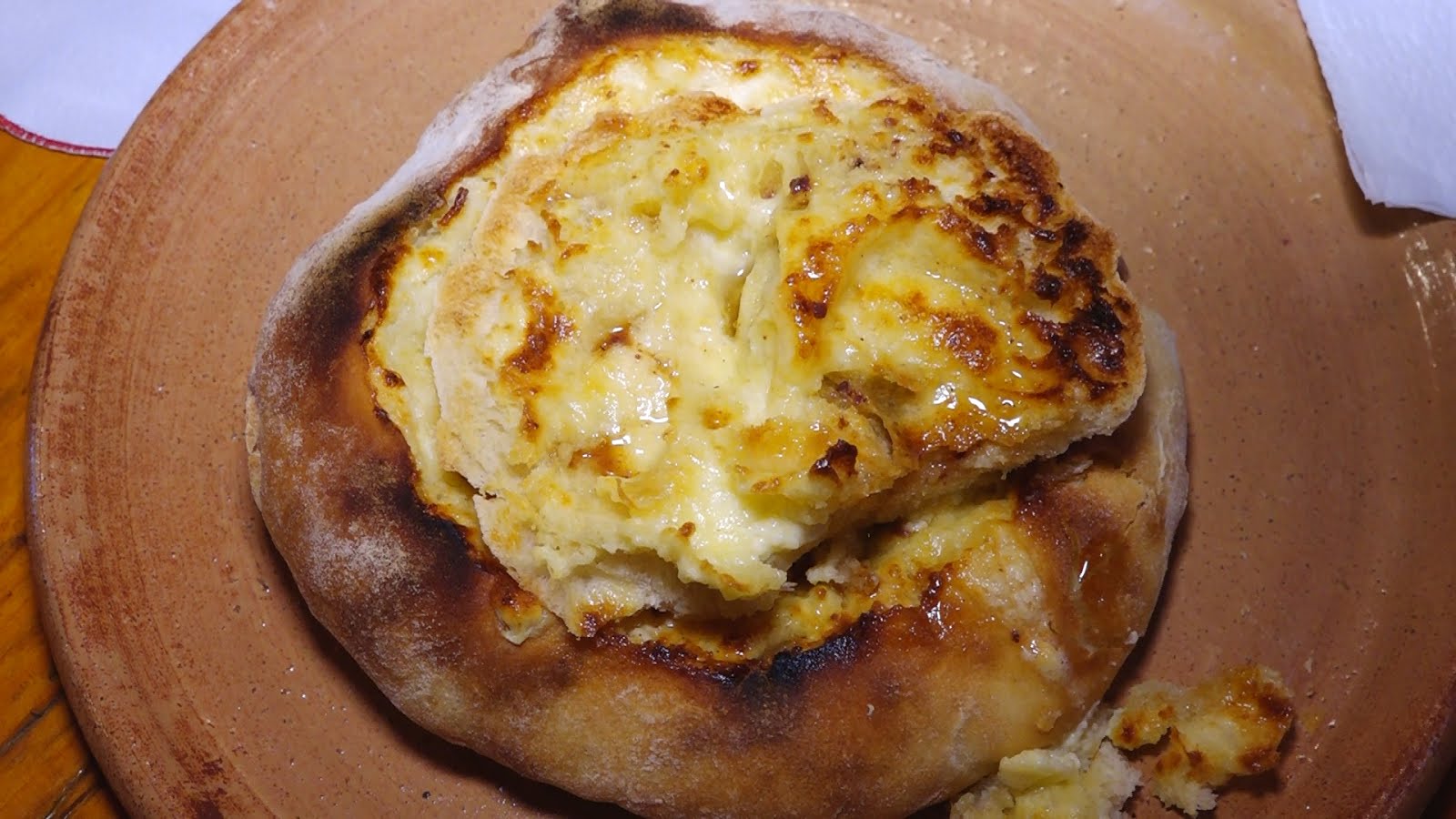 A big bun is hollowed out until it becomes a shallow bowl with a removable bread lid, and this is what the “bun with everything” is.
A big bun is hollowed out until it becomes a shallow bowl with a removable bread lid, and this is what the “bun with everything” is.
Chefs use a whisked egg and tangy, lightly fermented clotted cream (kajmak) to fill this basin.
They add drippings from a roasted lamb or pig (pretop) to the dense, bubbling mass within the bun after it has baked to a light golden color.
It is thought to have originated before WWII, and Dragan Lazić, the current owner of the bakery Kod Šuljage in Uice, was the first to record the name. This is a classic and one of the best Serbian food out there.
Want to make it at home? Click here!
Similar dishes to Komplet Lepinja are English Breakfast, Vegemite on Toast, Aloo paratha.
Where To Eat Komplet Lepinja: This Serbian Restaurant
Desserts
Vanilice
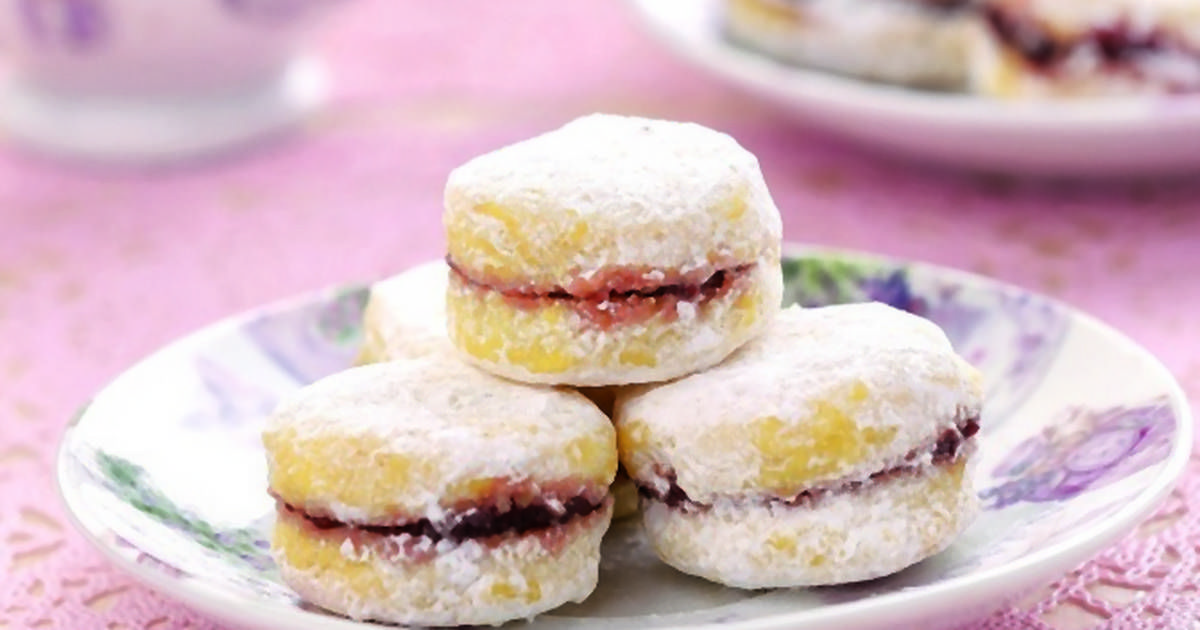
Vanilice are soft cookies, that contain a spice similar to vanilla, hence the name Vanilice. If you like shortbread, you will love these.
Although they are made throughout the Balkans and parts of the former Yugoslavia, there is an enduring tradition of making Vanilice at Christmas time in Serbia and by Serbian enclaves in neighboring countries.
Served with: Turkish coffee
Want to make it at home? Click here!
Similar dishes to Vanilice are Vanilla Cookies and jam sandwiches.
Where To Eat Vanilice: This Serbian Restaurant
Baklava
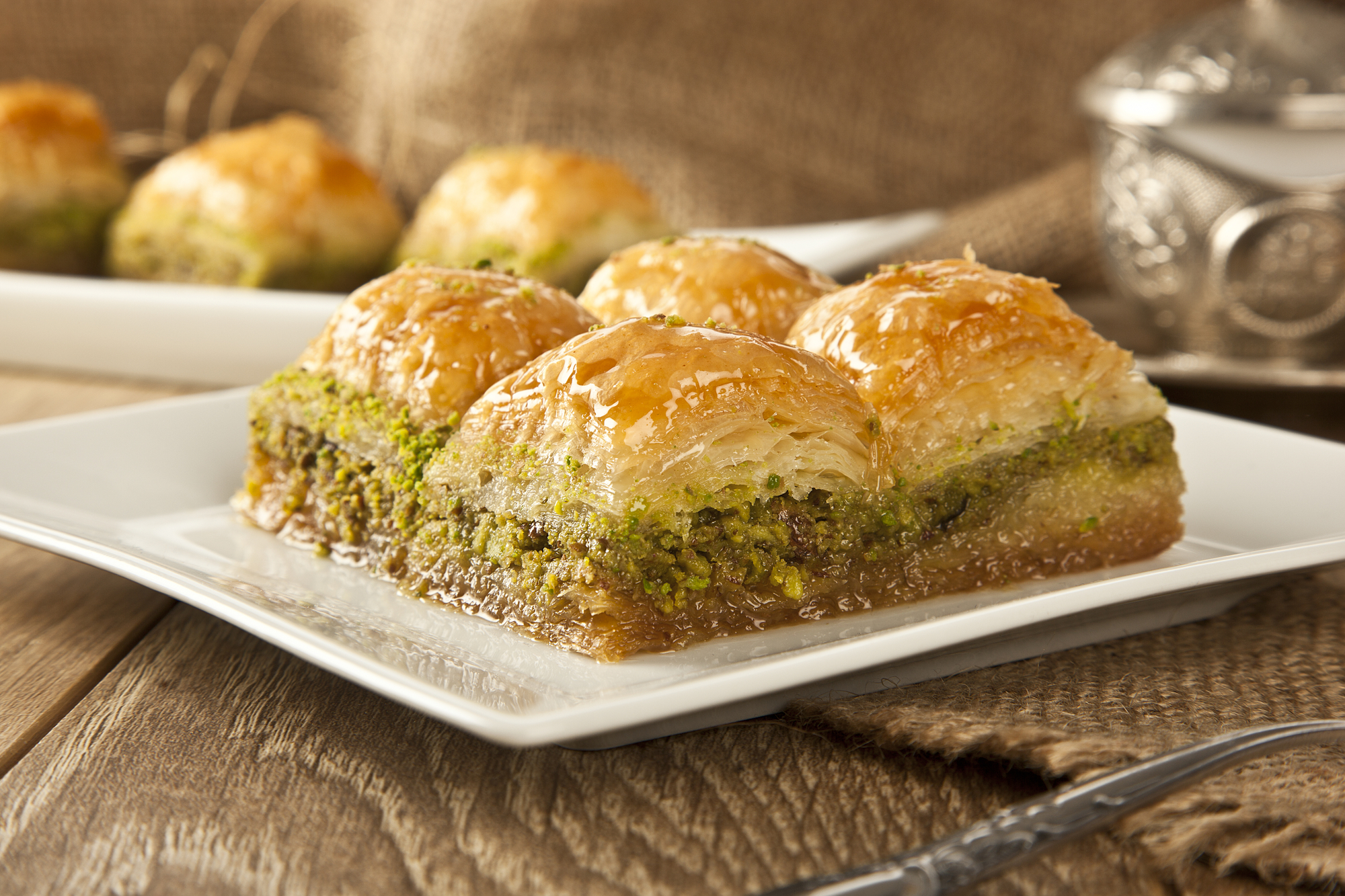
Baklava is one of the best Serbian food made of layers of filo pastry, filled with chopped nuts and sweetened with sugar syrup or honey.
Traditionally, phyllo dough is cut into large pieces so it can be easily managed by hand. It is lightly sweetened with a little sugar and layered with ground walnuts and then baked in a large pan. This recipe is really easy, but it takes several hours to cook.
Also, pistachios can be used and the taste will be still remarkable.
It has its roots in Ottoman cuisine and it never failed to amazed guests wherever or however served.
Served with: Turkish coffee
Want to make it at home? Click here!
Where To Eat Baklava: This Serbian Restaurant
Krofne
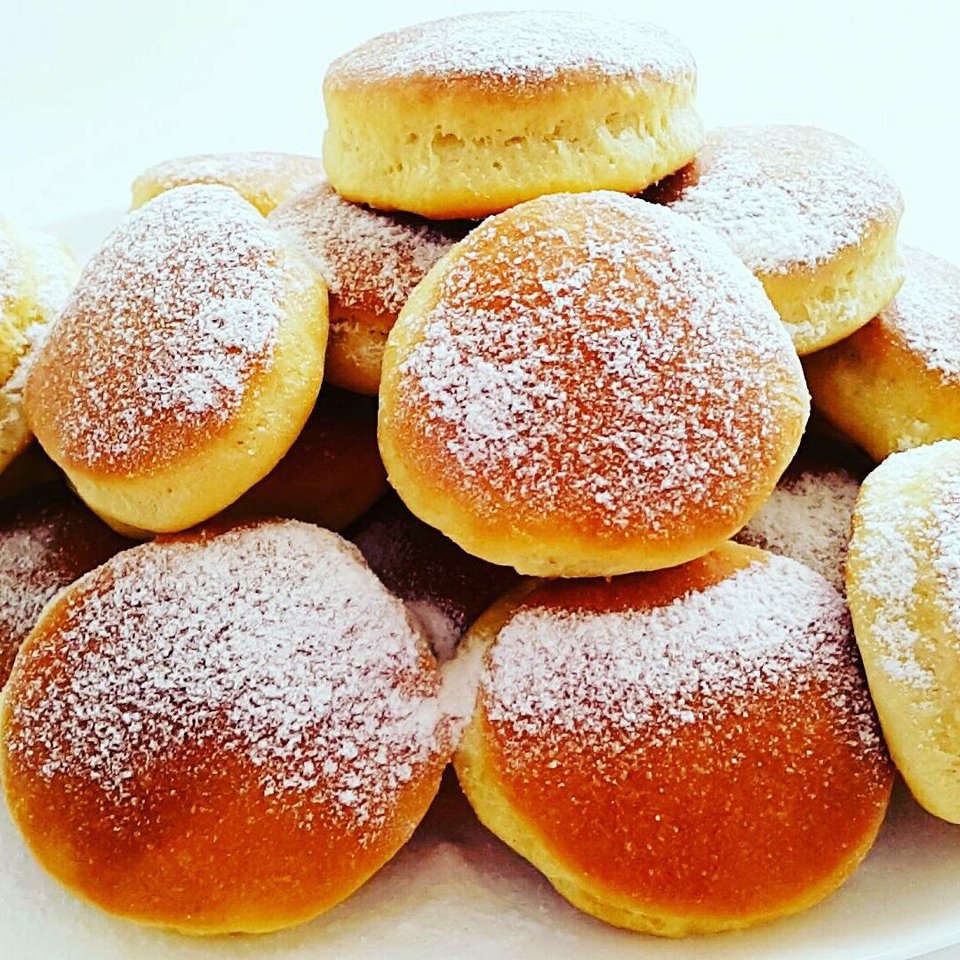
Krofne, or Serbian doughnuts, are delectable treats that can be enjoyed at any time of year, but particularly before the great lent begins.
They’re doughnuts with a light filling of jelly, marmalade, jam, or chocolate.
They can be filled with custard or cream as well, but this is less popular.
Want to make it at home? Click here!
Similar dishes to Krofne are Bola de Berlim, Pa thong ko, Malasadas.
Where To Eat Krofne: This Serbian Restaurant
Palačinke
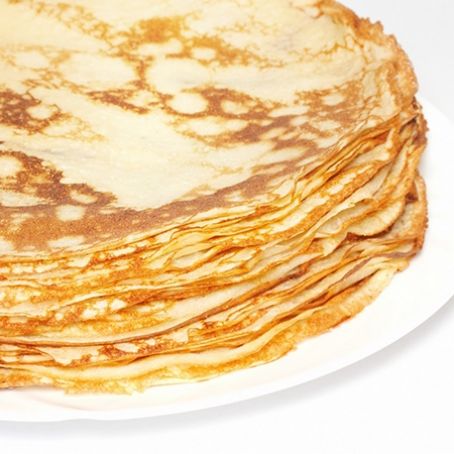
The popular Serbian version of pancakes is equally tasty! This is a crepe or pancake that is usually filled with melted chocolate, biscuits, walnuts, and honey.
You can find them easily all over the country, either as street food or in specialty stores. This truly can be one of the best Serbian foods.
Palacinke is native to Austria and Bavaria.
This dish has a long history, with its name being borrowed from so many Central and Eastern European countries. Throughout the Balkans and Europe, regional variants of palacinke can be found.
Want to make it at home? Click here!
Palacinke are similar to French crepes.
Where To Eat Palachinke: This Serbian Restaurant
Img src: https://www.tribugolosa.com/media/crepes-2-4_crop.jpg/rh/palacinke.jpg
Knedle
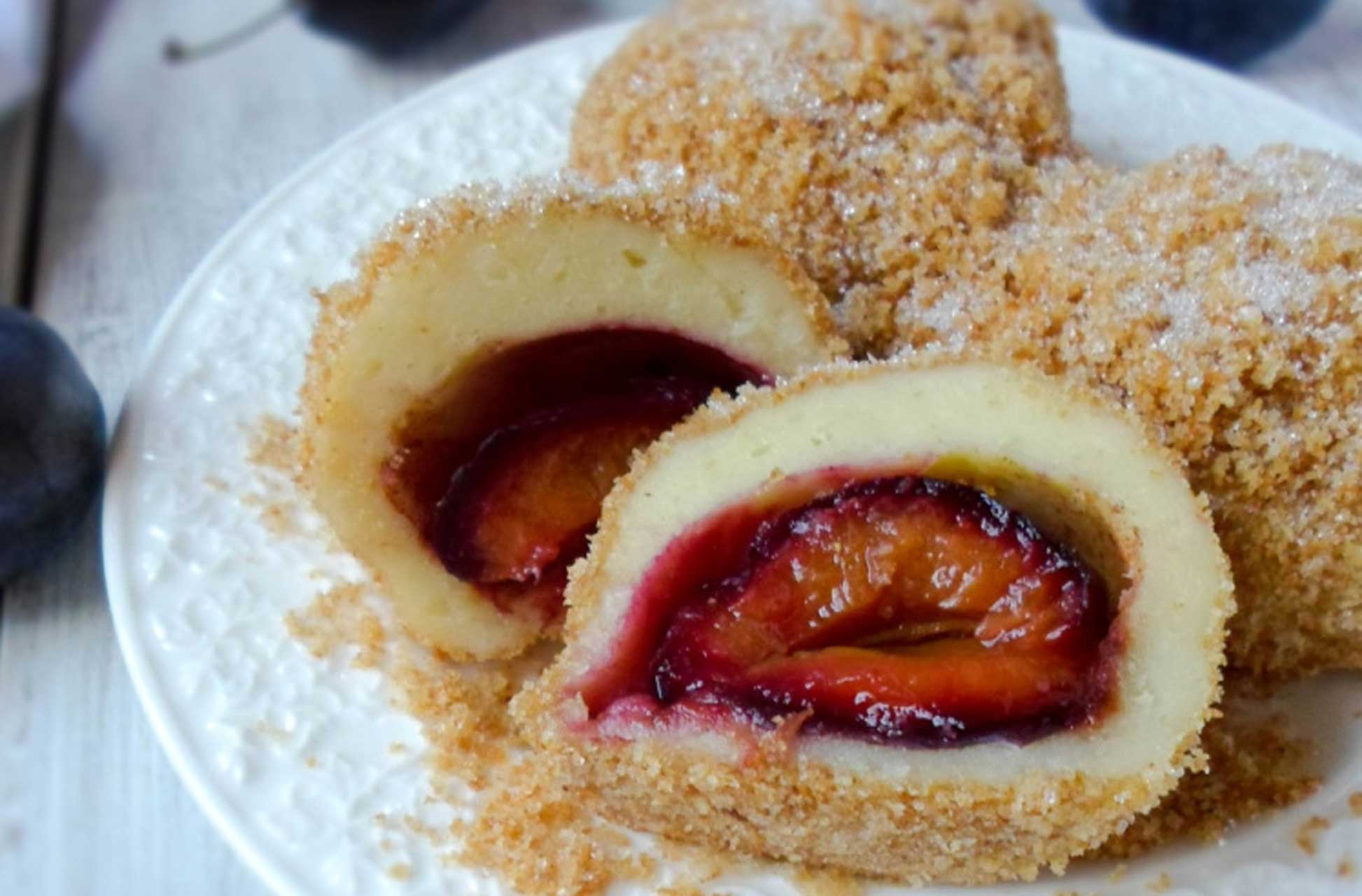 Knedle is an Austro-Hungarian dish consisting of boiled potato-dough dumplings filled with plums or apricots.
Knedle is an Austro-Hungarian dish consisting of boiled potato-dough dumplings filled with plums or apricots.
Mashed potatoes, eggs, and flour are used to make the dough. The dough is flattened and squares are cut out. finally, the plums (or apricots) are inserted inside the dumplings.
Want to make it at home? Click here!
Similar dishes to Knedle are Hoorische, Halušky, Kluski śląskie (yeah, read that again), Pyzy.
Where To Eat Knedle: This Serbian Restaurant
Slatko
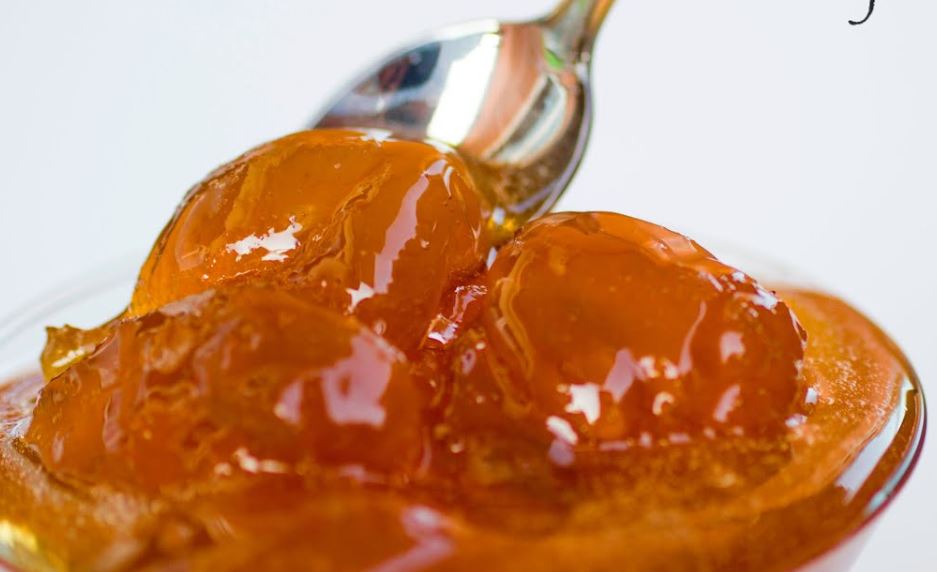 All around the Balkans, including Serbia, slatko is very popular and usually steals the shows when guests are offered one (three in our case).
All around the Balkans, including Serbia, slatko is very popular and usually steals the shows when guests are offered one (three in our case).
Slatko is a thin fruit preserve made of sliced or whole fruit or rose petals. Almost any fruit, such as wild strawberry, blueberry, plum, and cherry, can be used.
Slatko is used as a filling in pancakes and as a topping for ice cream and waffle shortcakes.
Slatko was only common and widespread in historical Serbia, south of the Sava and Danube, and was unknown in Vojvodina or other parts of the Austro-Hungarian Empire before the establishment of Yugoslavia.
Served with: Turkish coffee
Want to make it at home? Click here!
Where To Eat Slatko: This Serbian Restaurant
Vasina torta
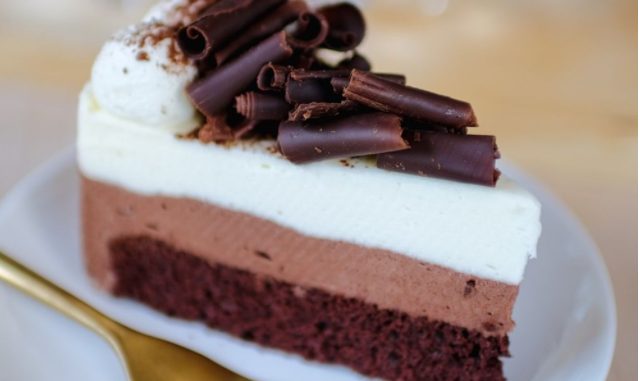
The best Serbian food includes the traditional cake, also known as Vasina torta; a dark chocolate orange cake with meringue that is popular in the Balkans.
The cake features three layers (a nut-based crust, a chocolate and orange icing, and an entirely meringue-based topping) of perfectly mixed citrus and chocolate flavors, as well as an (optional) chocolate glaze.
The cake was made as a gift from a mother-in-law to her son-in-law, Vasa okrljan from Parain, who took his wife to Vienna so she could give birth in better conditions than she could in Serbia.
It’s worth noting that oranges were a valuable commodity in Serbia in 1908, which is one of the reasons why this cake was so valuable.
Want to make it at home? Click here!
Vasina torta is a similar dish to Rigó Jancsi, Torta 900, Reform torta, Torta Setteveli.
Where To Eat Vasina torta: This Serbian Restaurant
Alva
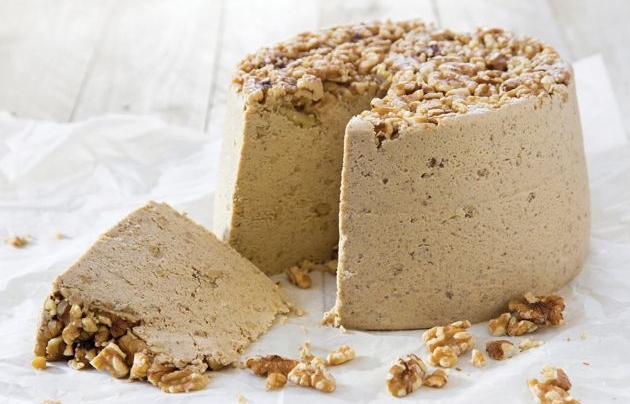
Alva, or Halva, is a traditional sweet that’s commonly served at church fairs around the world.
A semolina-based version called ćetena Alva is available in addition to the form made from sesame or tahini.
The latter is a semolina pudding with grapes, cinnamon, or raisins added to it. Honey is sometimes used as well.
Halva was invented in Persia. In the 7th century, a reference to halvah appeared, referring to a mixture of mashed dates and milk. The word was applied to a variety of sweets by the 9th century, including the now-familiar sweetened cooked semolina or flour paste.
Want to make it at home? Click here!
Tulumbe
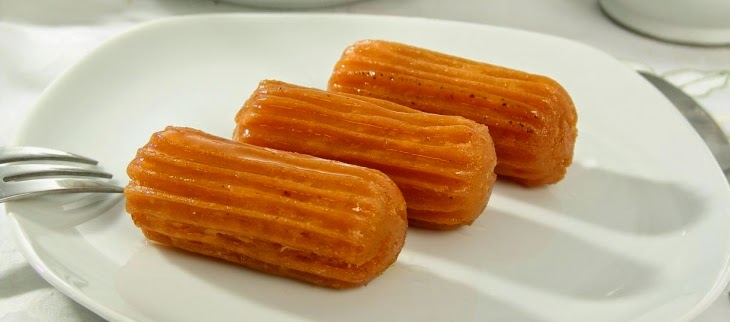 The syrup used to soak the dough is what gives this dessert its special flavor. Tulumbe has a fresh, soft, and slightly citrusy taste thanks to the syrup, which is made of sugar, vanilla extract, and lemon juice.
The syrup used to soak the dough is what gives this dessert its special flavor. Tulumbe has a fresh, soft, and slightly citrusy taste thanks to the syrup, which is made of sugar, vanilla extract, and lemon juice.
Tulumbe is a super sweet dessert that originated in the Ottoman Empire.
In terms of consistency, the dough is similar to French choux pastry in that it is light and smooth. Tulumbe are the sisters of the Spanish Churro.
Served with: Turkish coffee
Want to make it at home? Click here!
Where To Eat Tulumbe: This Serbian Restaurant
Reforma torta
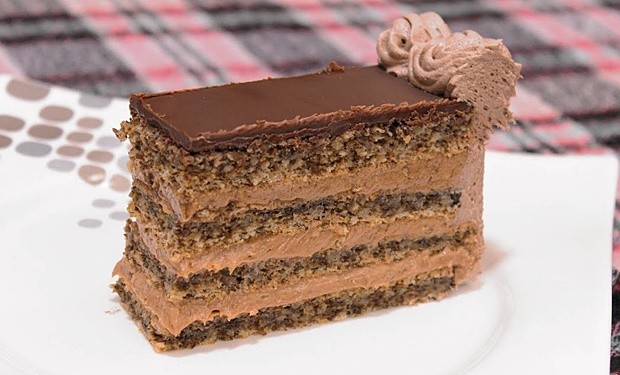
Reforma Torta is a Serbian cake with a creamy chocolate filling and a rich, multi-layered walnut sponge cake.
It’s an iconic Serbian cuisine dessert, and it’s difficult to imagine a party without it. Reforma Torta is common at Christmas and Easter, as well as for slavas in many families.
Want to make it at home? Click here!
Where To Eat Reforma torta: This Serbian Restaurant
Krempita
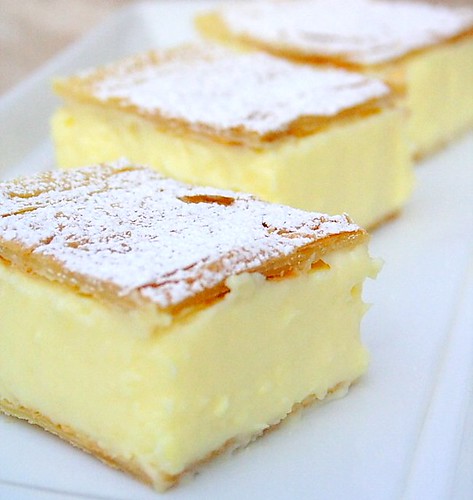
Many European countries are familiar with this delicious dessert made of crispy puff pastry sheets filled with vanilla custard cream but it holds a special place in Serbian cuisine.
The cream is made in a flash, and the most difficult part is waiting for it to set in the fridge.
Krempita is a vanilla slice or custard slice, a custard and chantilly cream cake dessert originating from the Austro-Hungarian Monarchy but whose exact origin is unknown. Tastes like heaven!
Want to make it at home? Click here!
Where To Eat Krempita: This Serbian Restaurant
10 more Restaurants to check out while in Serbia
New Rest, Riddle Bar, Maggaza Gastropub, Casa Nova, Restoran Ciribu Ciriba, Mezestoran Dvorište, Saran, Mala Gostionica, Smokvica, Kafana Question Mark.
Last Words (Too Much Food!)
Eating the best Serbian food is a culinary adventure, a delightful surprise of tastes and smells that will strike your senses as soon as you set foot in the country and begin your gastronomic journey.
One thing that draws many people to Serbian cuisine is its diversity. Created from regions with unique histories, cultures, and resources, the dishes are diverse in ingredients and preparation, and cooking methods.
Still hungry for Balkan food? Check out our guide on the:
- Krempita Recipe
- Struklji Recipe
- Qifqi Recipe
- Goulash Recipe
- Palacinke recipe
- Tavce gravce
- Tarator recipe
Want to spend those delicious calories? Go here:

Jadranka Y. and Pero K. Foodies, lovers. Jadranka is the queen of pastries and sweets, whereas Pero is the prince of meat and potatoes.
They met at 15, while working in the kitchen of a famous chef here in the Balkans, and have been together ever since.
But they still love each other and are faithful till death or until one messes up their dish. Which happens quite often if you ask anyone of them.
Love is a battlefield and Jadranka and Pero decide who wins, in the kitchen.